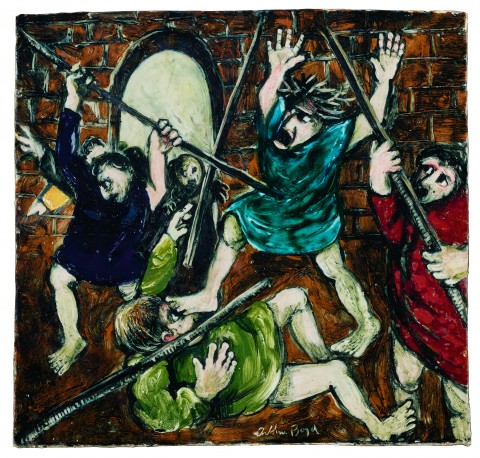THE MONEY CHANGERS, 1950 – 52
ARTHUR BOYD
glazed ceramic tile
40.5 x 42.5 cm
signed lower centre: Arthur Boyd
Geoffrey Dutton, Australia and United Kingdom,
Ninette Dutton (née Trott), New South Wales
Private collection, New South Wales, acquired from the above prior to 2007
We are grateful to Jamie Boyd and Polly Boyd for their assistance with this catalogue entry.
Ceramic Paintings by Arthur Boyd, Peter Bray Galleries, Melbourne, 26 August – 4 September, 1952, cat. 12
Philipp, F., Arthur Boyd, Thames and Hudson, London, 1967, p. 250, cat.37
Dutton, G., Out in the Open: an autobiography, University of Queensland, 1994, p. 215
Driving out the money changers, 1950, glazed ceramic tile. National Gallery of Australia.
The whale putting Jonah in its mouth, 1950, glazed ceramic tile. National Gallery of Victoria
The tribute money, c.1949, glazed ceramic tile. Australian Catholic University
Arthur Boyd was creating with clay almost as soon as he could walk, learning as he grew at the feet of his father Merric, Australia’s first studio potter-artist. In 1944, the younger Boyd established AMB Pottery at Murrumbeena with his brother-in-law John Perceval and the philosopher Peter Hebst. They utilised some of Merric’s old machinery bolstered by a new gas kiln; and with the easing of wartime restrictions, set about making earthenware to their own design with under-glaze painted decorations. As the decade drew to a close, Boyd sought wider avenues of expression, first through the construction of glaze-painted ceramic tiles and later in Picasso-esque sculpture. The money changers, 1950-52, is a powerful example of these pivotal works, not seen publicly since the artist’s close friend, poet Geoffrey Dutton, purchased it from exhibition in 1952. 1
The atmosphere at AMB Pottery was boisterous, filled with friends and family members working alongside the artists, a joyously chaotic environment captured by Perceval in such paintings as The pottery, 1948 (Deutscher and Hackett, 4 May 2016, lot. 10). Concurrently, Boyd was also painting significant works such as The mockers and The mourners (both 1945), parts of a cycle of Biblical paintings infused with the character of northern Renaissance artists, particularly Rembrandt and the earthier, rambunctious Pieter Bruegel the Elder.2 Similar imagery began appearing on the surface of the Murrumbeena ceramics with Boyd using the shapes of the vessels as creative stimulus for the sinuous lines of his brush. The artist’s fascination with Biblical stories started with his grandmother reading to him from an illustrated bible, ‘the tinted engravings in the text being as marvellous as they were bizarre.’ 3 It was these myth-legends that informed the narratives of the tiles, and as the series progressed, Boyd experimented with an increased darkness to his backgrounds, a tactic which ‘projects the figures forward – they often fill the pictorial field in height – in sharpened dramatic confrontation.’ 4 The money changers uses the tale of Jesus expelling the cashiers from the Temple (which appears in all four Gospels of the New Testament) as a starting point only, imagining a subsequent scene when guards have rushed in to subdue the rebel preacher. The fierce struggle between Jesus (identifiable through the symbolic Crown of Thorns in his hair) and the four guards, is anchored by the directional design of the spears, a ‘dominant pictorial rhythm, [allied with] a strong telling and pervading gesture.’ 5
When the first series of tiles was exhibited, critics wrote positively of the their likeness to stained glass and the ‘very immediacy of the work (which) commands admiration, and the senses respond without question to warm glowing colour, and the sparkling brittle textures imparted by the ground’; although another wrote churlishly that ‘Sunday School teachers will not be amused.’ 6 Regardless, Geoffrey Dutton’s admiration for his friend’s work was such that he later purchased a second tile from Boyd whilst in London in 1963 – but at a somewhat greater cost, exchanging it instead for the second-hand Rolls Royce he had purchased for the brief time he was based there.
1. Dutton also opened the exhibition for Boyd.
2. Pearce, B., Arthur Boyd: retrospective, Beagle Press, Sydney, 1993, p. 171
3. Gunn, G., ‘Tribute. Arthur Boyd: 1920-1999', Art and Australia, Sydney, vol. 37, no. 2, December 1999/January-February 2000, p. 207
4. Philipp, F., Arthur Boyd, Thames and Hudson, London, 1967, p. 68
5. ibid. an alternate version, Driving out the money changers, 1950, is in the collection of the National Gallery of Australia.
6. “The Age” Art Critic, ‘Art Notes: middle course could lead to beauty’, The Age, 26 August 1952, p. 2; & ;Shore, A., ‘Something new in art shows’, The Argus, Melbourne, 26 August 1952, p. 2
ANDREW GAYNOR
